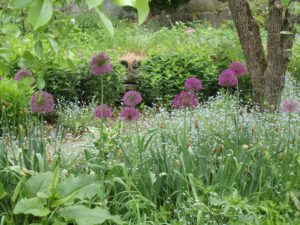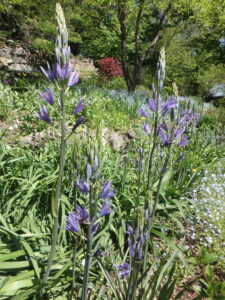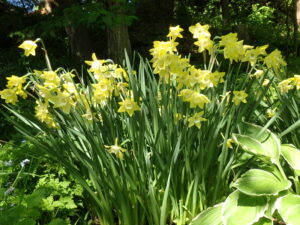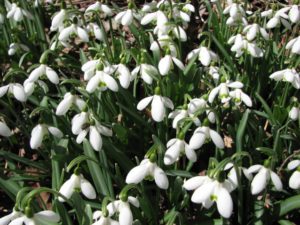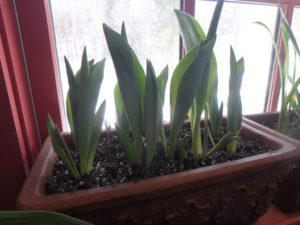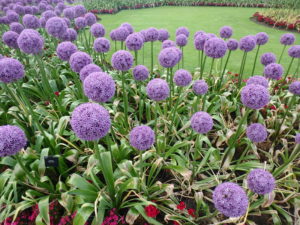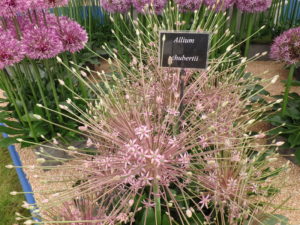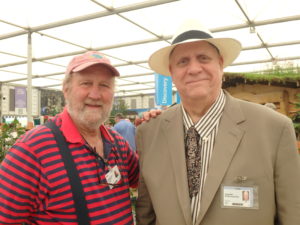Planting Bulbs for Spring Blossoms
First the small bulbs bloom: snowdrops, glory of the snow, scilla, winter aconite and crocus. Next come daffodils, tulips and alliums. Finally come summer snowflake ( Leucojum spp.) and Camassia. You have plenty of time to plant bulbs as you can do so until the ground freezes. But I recommend that you get them now before they are sold out. Gardening has taken a big uptick in interest this year, and I predict bulbs will go the way of seeds and hoses – all sold out early.
Planting depth matters. The small bulbs only need 2 or 3 inches of soil cover over the top of the bulb; bigger bulbs like tulips and daffodils generally need 6 inches of cover. Follow the directions that come with the bulbs.
I like to plant bulbs in big batches. Fifty daffodils will knock your socks off when they bloom, but five will hardly be noticed. I know that some stores sell tools that can be used to cut out and lift a circle of soil all in one motion. The idea is to dig lots of holes (3 inches across) and plant one bulb in each hole. I find that method tedious. The same goes for using an auger on a drill to dig holes for bulbs.
What I like is to dig a bulb bed for 25 or more bulbs. Dig down six inches, remove the soil in an oval or circle 24 to 36 inches across. I put the soil in a wheelbarrow or on a tarp so as to keep the area tidy. Once the hole is excavated, I add some bulb booster or slow-release organic fertilizer in the hole with my CobraHead weeder. I generally add some compost, too, and scratch it into the soil at the bottom of the hole, along with the fertilizer.
There are a few fall blooming bulbs, too. Saffron crocus and Colchicum need to be planted before this, but you might like to try them another year. Colchicum, generally planted in August, is also called “fall crocus” (even though it is not a crocus at all). But the blossoms look like giant crocus, and each bulb produces several blossoms. I love them.
Gardening: The Slowest of the Performing Arts
March has been ferocious. None of this “In like a lion, out like a lamb” business. The entire month has been a Tyrannosaurus Rex, if you ask me. I’ve done more roof-shoveling this month than I usually do in a year. My poor snowdrops, usually showing me their noses in early March, are still deep in snow. Sigh. But spring will come. It always does.
Snowdrops, my harbinger of spring, are best planted on a south-facing hillside. That way the snow melts off early, and allows them to push up through the frozen soil. Unlike tulips, their little white flowers look downward, so one must bend over and tip the blossoms up to see inside, which is always the most interesting view of a flower – all those stamens and pistils.
My snowdrops have multiplied over the decades. I don’t know if they move by seed, or if little rodents dig them up and move them around. I suspect it is by seed since they tend to move downhill into the lawn. Fortunately, they get all the sunshine they need to re-charge their batteries by the time I’m ready to mow the lawn. Daffodil leaves, on the other hand, don’t dry up until July, so I don’t plant them in the lawn.
Glory of the snow (Chionodaxa lucilae) is another small early bulb plant that will appear as soon as my snow disappears, and it has multiplied nicely over the years, too. I have it light blue, white and pink. Unlike snowdrops, the blossoms open with their faces up towards the sun – and us.
Scilla siberica, or squill, comes out just a few days after my glory of the snow and has a very intense purple color. Just a couple of inches tall, these small beauties look down, like the snowdrops. These do not multiply quickly, though their clumps or clusters do get more robust over time.
Bright yellow, school bus yellow, I associate with daffodils, and I have plenty of those that bloom in April and May. But before even the earliest are some short yellow blossoms of winter aconite (Eranthis hyemalis). I just learned that they are related to buttercups, which makes sense to me, given their color and flower shape.
Aconite are marginally hardy for me in Zone 4, but last spring I had many tiny ones, clearly first-year plants that developed from seed. I wonder if they will return and bloom for me this year. Such questions will get me outside and in the garden every day, should I ever get old and frail.
Many gardeners have given up on tulips because they are so tasty: to rodents that eat the bulbs, and to deer that consume the buds, blossoms and leaves. Not only that, most gardeners find tulips don’t return, year after year. I think of them as annuals since in year two I get half the number of blossoms I did in year one, and then only half of those come back to bloom in year three. No matter, I love them and plant them.
There are solutions to the tulip dilemma. First, I plant plenty each fall in clay pots and store them in my cold basement. Then, after 4 months of cold storage, I bring the pots into the warmth of the house and they bloom on the window sill. Right now I have some budding up, getting ready to bloom.
At the end of President Clinton’s tenure in the White House I got to interview the White House gardener, Dale Haney. The gardeners had just planted many thousand tulips, a pink one called Hilary Rodham Clinton! I always wondered if the Bush family asked the name of that one, and how President Bush felt about seeing Hilary tulips outside the Oval Office windows, waving at him in the breeze.
.
The White House grounds, I observed, were not only served by many gardeners, but occupied by many large, fat, lazy gray squirrels. I asked Mr. Haney about them. First, he explained, that our tax dollars paid for hundreds of pounds of sunflower seeds to feed the squirrels. A well-fed squirrel is less likely to dig up tulips, he said.
He also explained that the gardeners laid down chicken wire above the bulbs – but an inch or two below the soil surface. Thus if an unusually ambitious squirrel decided to lunch on a Hilary, it would be thwarted by the screening. I’ve tried that, but it’s a lot of work – and my little corgi and two aging cats seem to deter squirrels from digging up any tulips I plant outdoors.
Alliums are bulb plants that vary considerably in size and look according to the species or variety. They’re in the onion family, so not eaten by critters. I was amazed by all the diversity I saw last spring in London at the Chelsea Flower Show, and at Kew Gardens.
I’ve always had a few big ones outdoors, but last fall I planted some in pots to force indoors, as one spectacular variety I simply had to have, Allium schubertii, is only hardy to Zone 6 and would not survive outdoors here. I bought plenty of others that are hardy here in Zone 4 and can’t wait to see them perform.
Gardening – indoors or out – really is the slowest of the performing arts. Plant something, wait, hope. The anticipation, for me, is almost as important as the performance.
Henry is a UNH Master Gardener and the author of 4 gardening books. Reach him by e-mail at henry.homeyer@comcast.net.
The Chelsea Flower Show
It would be a bit of an exaggeration to say that I have always wanted to attend the Chelsea Flower Show in London. But not much. For years I’ve dreamed of going – and finally, this year, I went. Air ticket prices are down dramatically, the dollar is strong, and I decided there was no better time than now to cross off yet another item on my bucket list. It was well worth the effort.
Some basics: the Chelsea Flower Show is held on the grounds of the Chelsea Hospital in central London, which is now a retirement home for World War II soldiers. The show is bigger than anything in America: it encompasses 11 acres of displays, the vast majority of which are outdoors. That means that full-sized mature trees are installed, and in one case, a garden in a faux stone quarry was installed with blocks of stone stacked up more than 25 feet.
The show includes garden displays, rare plants, sculpture, food courts, vendors selling garden paraphernalia, music and much, much more. It has been an annual event since 1913 with the exception of a few years during the World Wars .
Tickets for next year’s show go on sale August 1, and although prices are not yet posted, tickets are not cheap – this year a full day ticket went for 100 pounds (($128). Each year the number of tickets is limited and they generally sell out before the event – this year some determined attendees apparently paid scalpers 500 pounds and more. It’s the Super Bowl of gardening.
If you want to go next year, the best plan is buy a membership to the Royal Horticultural Society, which allows you to attend a day before the doors open to the public, and offers discounted tickets.
I go to flower shows to learn. I delighted in seeing new (to me) species of flowers and new ways of combining flowers in the garden. I loved meeting garden experts and artists who created sculpture for the gardens.
So what are some of the things I learned? Thistles, which we generally consider weeds, can look great when planted in the garden. There I was in a city of millions, and a thistle, Cirsium rivulare ‘Atropurpureum’, was loaded with bees of all sorts! Clearly a great pollinator. Although a quick internet search did not lead me to seeds for that magenta-purple variety I saw there, I did find some seeds for a species native to the U.S. – Cirsium discolor – that is not the weedy pest farmers hate. So I shall order some seeds and try growing it.
Alliums were in all their glory at the show. Big, dramatic balls of flowers on 18- to 30-inch stems were used in many of the gardens. These are bulb plants in the onion family, and I have a few. I shall look for Allium schubertii which has an other-worldly pinkish flower head about 16 inches across. Another good one was just labeled with its variety name, ‘Powder Puff’.
Angelica (Angelica gigas) is another flower that was often used in the show. This is a 3- to 5-foot tall purple-leafed flower that I grew 25 years ago, but it is a biennial that does not come back after flowering, and I dropped it from my plant palette. But I have already purchased and planted one since returning from the Chelsea show. It can be very dramatic in the garden.
Ferns were used as filler in many of the gardens at Chelsea, and I shall try using them, too. Of course, their gardens only had to look good for 6 days, so ferns that spread, or get too tall, were not a problem, though they might be in my garden. I have a patch of Japanese Painted Fern (Athyrium niponicum) which is great in dry shade. But this summer I will investigate other ferns. Many nurseries sell them, but I admit I haven’t paid much attention to them.
Interesting people I met? George Ball, owner of Burpee Seeds was there. He is a highly knowledgeable (and opinionated) plantsman who is passionate about seeds. I was interested to learn from him that Melania Trump’s grandfather was a Slovenian onion breeder.
Mr. Ball pointed out that most vegetable seeds originally came from Europe, which is actually farther north than we are – and hence not good choices here. He believes that modern hybrids, not heirloom seeds originally from Europe, are best. And he told me that in a blind taste test, 4 of 5 times, Burpee’s hybrid ‘Brandy Boy’ beat the heirloom ‘Brandywine’, which is one of my favorites for flavor. I am trying it this year, since it ripens earlier, and produces more fruit, according to him. I’ll let you know how mine do in August.
At a reception on press day by David Austin Roses for a new rose named after actress Dame Judi Dench, who was there, I met the 91-year old founder of the company. I was able to thank him for all the beauty he has introduced to the world.
The English know how to throw a party – or have a flower show. Picnics with champagne were everywhere. Women were dressed in flowered clothes and elegant garden hats; men wore suits, even in the hot sun. Of course, everyone was very polite. And I got to check off another item on my bucket list.
Read Henry’s twice-weekly garden blog at https://dailyuv.com/



